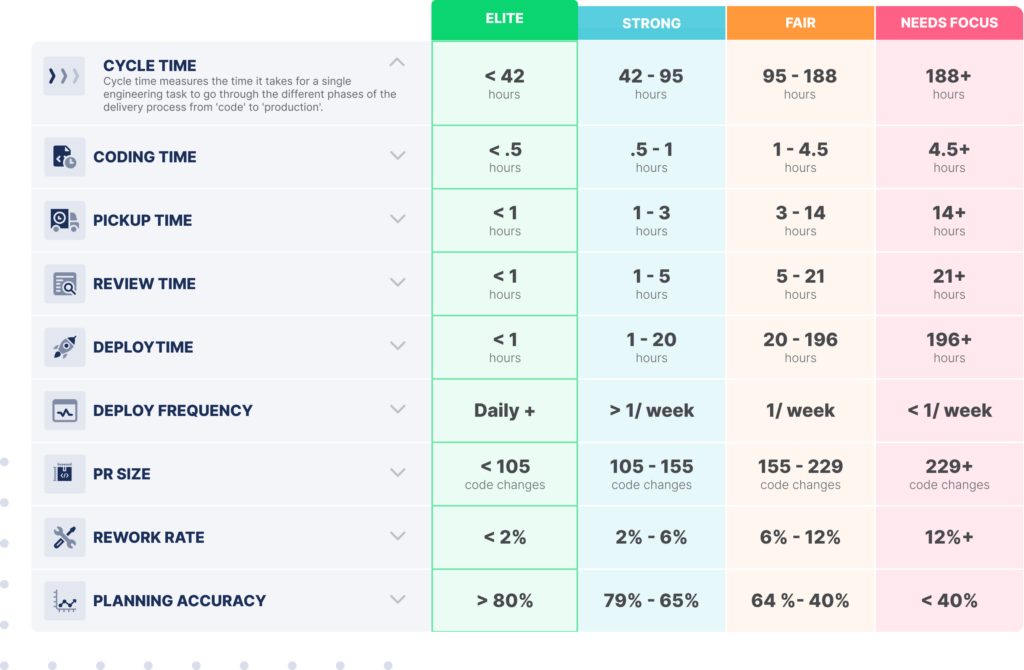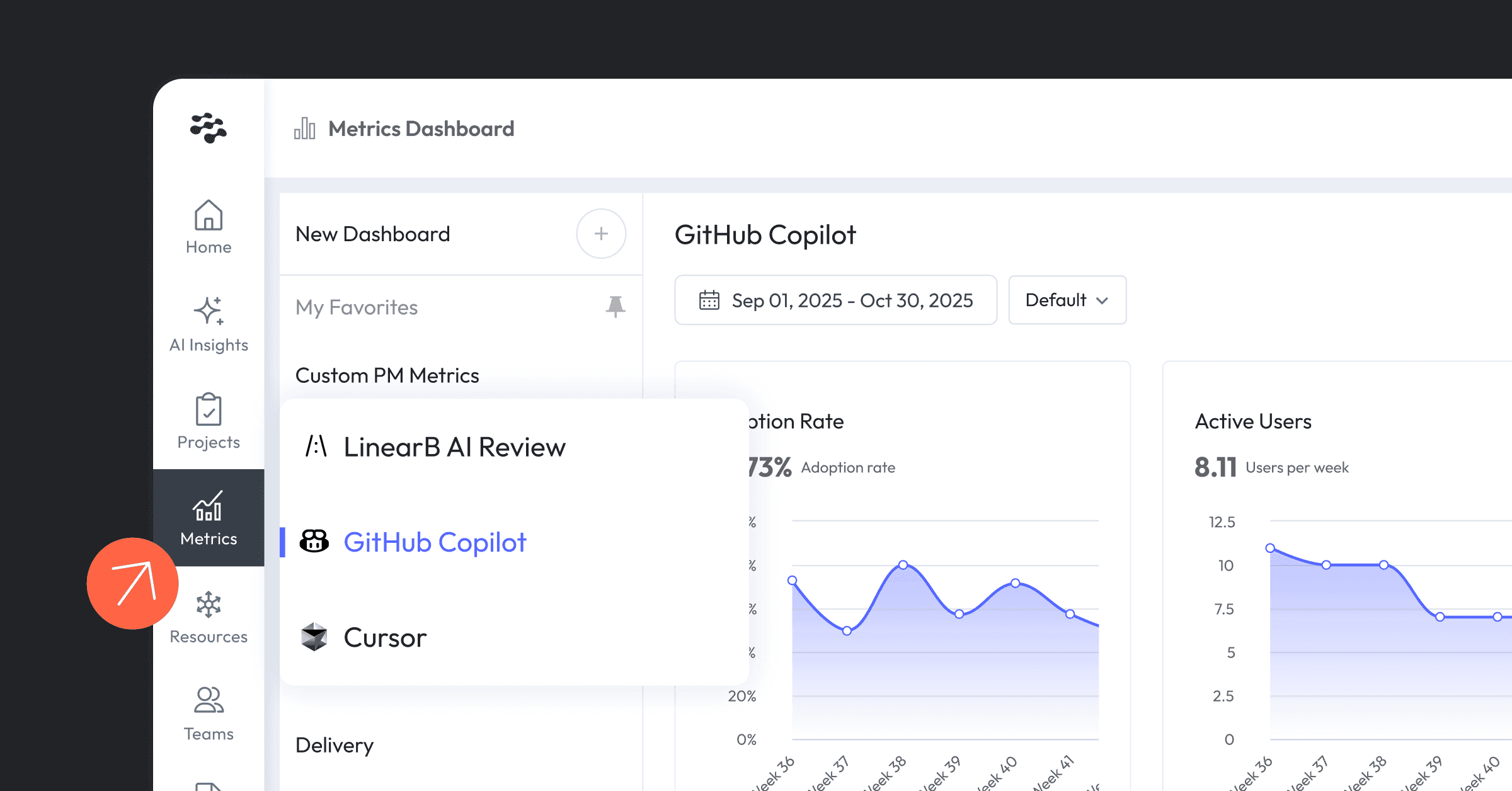Leading software development teams can feel like piloting an airplane on pure instinct sometimes. But you won’t be able to immediately detect problems and keep your flight on track without your dashboard, gauges, and metrics panel.
And because teams are working on different aspects of a product, you don’t always have the data to know exactly what they’re working on. It’s not like you have an air traffic controller to give you directions either — you need a way to visualize your org’s progress yourself.
That’s where engineering intelligence tools come in. Just like a pilot’s console, these tools help you quickly identify problems and recalibrate, so your org stays on track.
In this article, we’ll define engineering intelligence, what makes an engineering intelligence tool effective, and the best options available today.
Table of Contents
- What Is Engineering Intelligence?
- What to Look for in an Engineering Intelligence Tool
- 5 Best Engineering Intelligence Tools
- How to Improve Your Engineering Metrics
What Is Engineering Intelligence?

Source: I.pinimg
Just like business intelligence, engineering intelligence takes the data produced in your daily operations, and helps you visualize it to improve your processes. Engineering intelligence tools run specialized calculations on collected data, and give you details that can help you make strategic and tactical decisions for your org.
With this data visualization and real-time insights, you’ll be able to quickly identify what problems your teams are facing — whether it’s inefficiencies, technical debt, or declining performance. You’ll then be able to take action to resolve those issues straight away.
So in a nutshell, engineering analytics platforms gather data so you can show your execs what your teams are working on. They also pinpoint any bottlenecks in your processes so you can remove them.
So in a nutshell, engineering analytics platforms gather data so you can show your execs what your teams are working on. They also pinpoint any bottlenecks in your processes so you can remove them.
What to Look for in an Engineering Intelligence Tool
Sorting through all the available engineering intelligence tools can take some time. To help speed things up, we’ve highlighted four key features you should focus on when selecting the best tool for your org:
- High-quality metrics: Just because you have access to tons of metrics, doesn’t mean you need them all. Your platform should show you actionable metrics, like DORA metrics, not empty metrics like lines of code.
- User-friendliness: Having a data set is great, but tools like Jira don’t exactly make it easy for you to access it. Your engineering intelligence tool needs to give you accurate data without much hassle.
- Ease of use: You don’t want to drown in a vast ocean of unintelligible data and SQL queries. Your engineering intelligence platform should give you the valuable insights you need, at a glance.
- Visibility into roadblocks: Your engineering intelligence platform should help you spot all bottlenecks and give you tools to eliminate them.
5 Best Engineering Intelligence Tools
The five tools we’ve chosen are all easy to use, offer great metrics, and enable you to get started with them right away!
1. Power BI
Power BI is an integrated and scalable business intelligence tool for individual users and large organizations. This enterprise-grade tool aims to provide the most in-depth look into your data.
Power BI also comes with a dashboard that gives you a centralized view of all the data you need. And with its detailed, built-in reporting, you can get actionable insights to track down and eliminate bottlenecks in your processes.
2. Propelo
Propelo facilitates data transformations and safe, reliable, and consistent product delivery. This engineering intelligence tool offers key DevOps insights while empowering your dev teams with no-code workflow automation.
Leveraging your existing data, Propelo enables you to see how your teams are performing at a glance. It also offers insights for how you can remove potential roadblocks. Your teams can then set up contextual automation to streamline routine tasks.
3. Uplevel
Uplevel gives you complete insights into your engineering org’s efforts so you can plan confidently. Uplevel’s long-term goal is to create a world where engineers are happy to work, not getting burnt out from the constant stream of tasks.
This tool delivers comprehensive and actionable data-driven insights, allowing teams to make incremental improvements that have a significant impact. Uplevel also blends data science with organizational science to give you a comprehensive picture of your entire org. This way, you can help engineering leaders work on things that truly align with business needs.
4. Embold
Embold scans your repositories for code quality, helping teams become more familiar with their software. This eliminates tech debt, because it facilitates efficient source code data analysis. Embold also draws attention to problems that could compromise the code’s stability, integrity, and resilience before they become significant obstacles.
This engineering intelligence tool offers a straightforward user interface and several powerful analytics tools that give you real-time info about your programs. Embold features a flagging system at the component level to help your developers find the bug’s exact location. It then uses artificial intelligence to rank issues based on severity, so your teams can get clear, actionable plans.
5. LinearB
LinearB is a comprehensive platform that gives you dashboards, reports, and real-time alerts on what your teams are working on. To do that, it integrates with your Git and project management tools. It then uses industry-standard engineering benchmarks to show you how your org is performing.

LinearB will also give you clear insights into issues that may be slowing down your workflow. And with that data, you can make actionable plans to streamline your pipeline and identify areas of improvement for your engineering org.
As a result, you’ll be able to usher your entire engineering org into a new golden age centered around three key pillars: developer experience, engineering tempo, and business alignment.
How to Improve Your Engineering Metrics
Engineering intelligence tools give you a clear view of your engineering org’s performance and the power to improve it. Metrics alone don’t improve dev teams, but you can use them to visualize your processes and clear out obstacles.
LinearB helps you track the right metrics and improve them. You can use our engineering benchmarks to figure out where your org is falling behind. You can then set Team Goals to reach these standards and actually track your improvement. You can even celebrate your org’s progress and successes with custom notifications.
After that, our WorkerB bot helps your teams more easily reach their targets. It allows devs to automate routine tasks like creating Jira tickets, and even gives context to reviewers to speed up the PR process.
And paired with gitStream, your teams will be able to automate PR routing using policy-as-code. This way, code won’t get stuck in reviews for days on end, and your PR process will be much more efficient overall!





